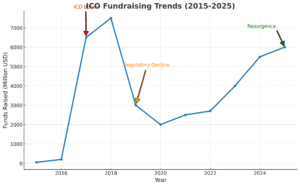Launching a successful ICO in 2025 requires not only technical and marketing expertise but also compliance, community building, tokenomics strategy, and investor trust. Initial Coin Offerings (ICOs) were once considered the “wild west” of fundraising in the blockchain space. Between 2017–2018, projects raised billions, but many failed due to lack of regulation, transparency, and sustainability. Fast forward to 2025, the ICO landscape is more mature, regulated, and competitive.
This guide will walk you through everything you need to know — from pre-ICO planning to post-launch execution.
Launch ICO Step by Step
Understanding the ICO Landscape in 2025
1.1 The Evolution of ICOs
- 2017–2018 Boom: Frenzy-driven fundraising with little oversight.
- 2019–2021 Shift: Emergence of IEOs (Initial Exchange Offerings) and STOs (Security Token Offerings).
- 2022–2024 Regulation: Countries introduced stricter compliance (AML/KYC, FATF Travel Rule).
2025 Landscape: ICOs still exist, but only projects with strong fundamentals, clear utility, and transparent governance succeed.
1.2 Current Market Trends
Investors prefer utility-driven tokens with real-world use cases.
Decentralized communities drive demand through governance and DAOs.
Hybrid models (ICO + IDO/IEO) are common for dual exposure.
Compliance-first approach is critical to avoid legal setbacks.
Pre-ICO Planning
2.1 Defining Your Vision and Problem Statement
Every successful ICO starts with a clear mission. Investors want to know:
- What problem does your project solve?
- Why is blockchain the right solution?
- How does your project stand out from existing competitors?
2.2 Market Research and Feasibility Study
- Analyze competitors in your niche (DeFi, NFTs, gaming, AI, supply chain).
- Assess demand for your token utility.
- Validate assumptions with surveys, pilot launches, or MVPs.
2.3 Assembling the Right Team
Investors in 2025 invest in people as much as in technology. Your team should include:
- Blockchain Developers (smart contracts, security).
- Legal Advisors (jurisdiction, compliance).
- Financial Experts (tokenomics, treasury management).
- Marketing and Community Managers (global reach).
Transparency is crucial. Public LinkedIn profiles, verified identities, and advisory boards add credibility.
2.4 Choosing the Right Jurisdiction
Popular jurisdictions for ICO registration in 2025:
- Switzerland (Crypto Valley) – robust but strict.
- Singapore – friendly yet regulated.
- Dubai (VARA) – attractive for crypto innovation.
- Estonia & Lithuania – fast licensing, EU access.
Tokenomics Design
3.1 Determining Token Utility
Ask: what role does the token play in your ecosystem?
- Utility: payments, access, governance.
- Incentives: staking, liquidity rewards.
- Burn mechanisms: to manage inflation.
3.2 Token Supply and Allocation
Key allocation buckets:
- Public Sale: 30–40%
- Team & Advisors: 15–20% (with vesting schedules)
- Ecosystem Development: 20–30%
- Reserves: 10–15%
- Community Rewards: 10–15%
3.3 Pricing Strategy
- Avoid unrealistic valuations.
- Offer early-bird discounts or private rounds.
- Consider dynamic pricing models like bonding curves.
3.4 Vesting and Lock-ups
To prevent dumping:
- Team Tokens: vested over 2–4 years.
- Investor Tokens: partial release, with cliffs.
Legal and Regulatory Compliance
4.1 KYC/AML Compliance
- Mandatory across most regions.
- Use trusted providers for identity verification.
4.2 Security Laws and Utility vs. Security Tokens
- Utility Token: access or use case inside the ecosystem.
- Security Token: promises profit or resembles equity (requires SEC/FCA/ESMA compliance).
4.3 Jurisdiction-specific Rules
Always consult a crypto-legal firm to navigate nuances.
Building Technology Infrastructure
5.1 Smart Contract Development
- Use audited code (Solidity, Rust, Vyper).
- Implement fail-safes for token minting and transfers.
5.2 Security Audits
No ICO can succeed in 2025 without a credible audit. Leading firms include CertiK, Hacken, and SlowMist.
5.3 Token Standards
- ERC-20 / ERC-777: fungible tokens.
- ERC-721 / ERC-1155: NFTs.
- Cross-chain standards: for interoperability.
5.4 Launchpad and Platform Selection
Options:
- Self-hosted ICO (on your website).
- IDO platforms (Uniswap, PancakeSwap, Sushi).
- IEO via exchanges (Binance, KuCoin, OKX).
Marketing and Community Building
6.1 Branding and Messaging
Your ICO must communicate:
- Simplicity of vision.
- Real-world utility.
- Trustworthiness of the team.
6.2 Website and Whitepaper
- Website: clean, fast, optimized for Core Web Vitals.
- Whitepaper: 25–40 pages, covering vision, tokenomics, roadmap, legal disclaimers.
6.3 Social Media and PR
- Twitter (X), LinkedIn, Telegram, Discord are must-haves.
- Launch AMA sessions, podcasts, YouTube explainers.
- Engage crypto influencers and KOLs carefully (authenticity matters in 2025).
6.4 Community Incentives
- Airdrops: to attract early users.
- Bounties: bug reporting, content creation.
- Referral Programs: gamified rewards.
Fundraising Strategy
7.1 Private vs. Public Sale
- Private Rounds: attract VCs, angels, and strategic partners.
- Public ICO: mass participation.
7.2 Tiered Sale Models
- Early investors receive bonuses.
- Later rounds priced higher.
7.3 Payment Methods
- Accept ETH, BTC, USDT, USDC.
- Multi-chain participation boosts accessibility.
Launch Execution
8.1 Smart Contract Deployment
- Testnet trials first.
- Deploy on mainnet with multi-sig wallets.
8.2 ICO Dashboard
Features to include:
- KYC integration.
- Real-time token sale tracker.
- Investor wallet connection.
8.3 Exchange Listings
- Target both centralized and decentralized exchanges.
- Negotiate liquidity pools for smooth trading.
Post-ICO Activities
9.1 Token Distribution
- Automate distribution through smart contracts.
- Maintain transparency with explorers.
9.2 Treasury Management
- Diversify holdings (stablecoins, BTC, ETH).
- Build reserves for bear markets.
9.3 Continuous Community Engagement
- Quarterly updates, roadmaps, AMAs.
- Involve community in governance decisions.
9.4 Product Development
- Funds raised should go toward delivering your MVP and scaling adoption.
- The best ICOs prove utility within 6–12 months post-launch.
Risk Management
10.1 Security Risks
- Hacks, rug pulls, phishing.
- Mitigation: audits, bug bounties, insurance.
10.2 Regulatory Risks
- Changes in laws may impact operations.
- Always maintain compliance readiness.
10.3 Market Risks
- Token value volatility.
- Address through buybacks, staking, or burns.
Case Studies of Successful ICOs
- Ethereum (2015): Pioneer, raised $18M.
- Filecoin (2017): Raised $257M, strong utility.
- Chainlink (2017): Became oracle leader.
- New Age ICOs (2023–2025): Focus on AI + Blockchain, DeFi 2.0, and RWAs (Real-World Assets).
Key lesson: Projects succeed not just by raising money but by delivering real utility.
Checklist for Launching a Successful ICO in 2025
- Define clear vision and problem statement.
- Conduct market research and feasibility analysis.
- Assemble credible team and advisors.
- Select compliant jurisdiction.
- Design robust tokenomics with vesting.
- Draft legal documents and terms.
- Build and audit smart contracts.
- Prepare website, whitepaper, pitch decks.
- Launch marketing and community campaigns.
- Conduct private and public sales strategically.
- Deploy ICO smart contracts and dashboards.
- Distribute tokens and manage treasury.
- Engage community and deliver roadmap.
Conclusion
Launching a successful ICO in 2025 is far more complex than in the early days of crypto. It demands regulatory compliance, strong tokenomics, transparent governance, innovative technology, and a loyal community. Projects that focus on long-term sustainability, not just fundraising, will stand out in a maturing ecosystem.
FAQs
Yes, ICOs are legal in most countries, provided they comply with securities and AML/KYC regulations. The definition of utility vs. security token is crucial.
Depending on jurisdiction, audits, and marketing, costs can range from $200,000 to $2 million.
From planning to execution, typically 6–12 months.
Ethereum remains dominant, but BSC, Polygon, Solana, and Cosmos chains are popular for scalability and cost-efficiency.
Still critical. A professional whitepaper demonstrates legitimacy, explains tokenomics, and builds investor trust.
Many projects use a hybrid approach. ICO builds independence, IDO gives DeFi exposure, IEO offers exchange backing.
Depends on jurisdiction. In most regulated regions, yes, especially if tokens have security-like properties.
Strong community, transparent tokenomics, audited contracts, and authentic marketing matter more than hype.
Use multi-sig wallets, audited contracts, and bug bounty programs. Cybersecurity insurance is also an option.
Overpromising and underdelivering. Sustainable growth and utility delivery are more important than raising quick funds.






